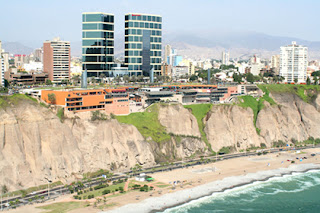 |
| An aerial view of the historical center of Cusco. |
First week in Cusco (when this was written…I swear)!
This week is all about straightening out my projects, meeting with experts and friends, and getting used to the altitude and Spanish.
Since Cusco is at 3,500 meters, side effects are to be expected.
Mine include heavier breathing whenever I am walking.
As most of you know, I love to walk everywhere, but it is difficult to do so with the altitude – one senior citizen even offered me her cane when I was walking up the street to my hostal.
It was so sweet, but a bit embarrassing at the same time.
 |
The resident llama of the site.
|
A bit about the work that I will be doing here: One of my projects here is assembling what we know about an important ritualistic site called the Kusikancha in the center of Cusco. The purpose of the site (we think) was to house foreign head priests of indigenous cults outside of Cusco. In the past, there has only been one book published about it. Unfortunately, the book goes off on a tangent and talks about another site for the majority of it. My job right now is to organize what we have, publish the excavation records, and create a 3-D model of what was there. Another feature of the site is the fauna; there are two vicunas and one llama that make the Kusikancha their home. While they look cute, they are quite aggressive because they chase and spit at people – the archaeologists at the site have learned to avoid them.
 |
The Kusikancha! It does not look like much right now,
but it was one of the most important ritual sites in the Inca Empire. |
My second (and principal) project here is creating a map of Inca shrines in the northeastern part of Cusco. These shrines can be fountains, caves, manmade constructions, and other prominent natural formations. I am limiting my study to carved stone. So far, we have identified 15-20 of these shrines! It is really incredible how thorough the Inca were at leaving their mark around the landscape. More details about this project later.
 |
A cave that was once a shrine.
There is a small rock in the middle
that is perfectly round and was probably
brought here from a distance. |
 |
| An alligator carving in a rock that was once a shrine. |
My third (and second unofficial project) is about how two poets (Pablo Neruda and Martin Adan) approach Machu Picchu in their work. It was quite difficult to acquire a copy of the Adan book – since he died in 1985, his books have not been widely circulated. To get this book, I went to the local university and met some poetry experts who work there. More about this later…
 |
| The famous cuy. |
Food here is absolutely incredible! Perhaps the most famous type of food here is the cuy. According to locals, it is not guinea pig. From how it was explained to me, a cuy is uglier than a guinea pig but cleaner than a rat. Apparently, it is a clean but ugly rodent. Other dishes include lomo saltado (my favorite!), chicha morada (a purple corn drink), and LOTS of desserts. (Cusco even has separate cake shops and chains.) OK, I need to get lunch, these descriptions are making me hungry.
 |
| Chicha morada |
More updates soon…


























